![]()
![]()
![]()
Use LEFT and RIGHT arrow keys to navigate between flashcards;
Use UP and DOWN arrow keys to flip the card;
H to show hint;
A reads text to speech;
86 Cards in this Set
- Front
- Back
|
Name two combining forms that both mean abdomen
|
abdomin/o
lapar/o |
|
|
Name three prefixes that all mean above
|
epi-
supra- hyper- |
|
|
Name three prefixes that all mean below or under
|
sub-
infra- hypo- |
|
|
Name the prefix that means the opposite of hypo-, and define the meaning of both prefixes.
|
hyper-
hyper- means excessive, above, more than normal hypo- means deficient, below, less than normal |
|
|
Name three prefixes that all mean through
|
trans-
dia- per- |
|
|
The prefixes en-, end-, endo-, and intra- all mean what?
|
within, in
|
|
|
The prefixes ec-, ecto-, ex-, and exo- all mean what?
|
out, outside of, outward
|
|
|
Name four prefixes that mean the opposite of en-, end-, endo- and intra- and define the meaning of both groups of prefixes.
|
ec-, ecto-, ex-, and exo-
ec-, ecto-, ex-, and exo- all mean out, outside of, outward en-, end-, endo-, and intra- all mean within, or in. |
|
|
The following suffixes all mean what?:
-ac, -al, -ar, -ary, -eal, -iac, -ic, -ical, -ior, -ous, -tic, -ose |
pertaining to
|
|
|
Name at least 5 suffixes that all mean "pertaining to".
|
-ac, -al, -ar, -ary, -eal, -iac, -ic, -ical, -ior, -ous, -tic, -ose
|
|
|
What is the common meaning among the follow suffixes?:
-ia, -osis, -ism, -y, -sis |
condition
|
|
|
What is the common meaning among the following suffixes?:
-ism, -ion, -y |
process
|
|
|
Name two suffixes that can mean both "process" and "condition"
|
-ism, -y
|
|
|
The suffix -ia means _________.
The suffix -ion means _________. |
The suffix -ia means condition.
The suffix -ion means process. |
|
|
The suffix -sis means "condition", but it can also mean __________.
|
state of
|
|
|
The suffix -emia means ________.
The suffix -pathy means ________. |
The suffix -emia means blood condition.
The suffix -pathy means disease condition. |
|
|
Explain the meanings of the following prefixes:
infra- inter- intra- |
infra- means beneath, under
inter- means between intra- means within, in, into |
|
|
Name the prefix that means the opposite of tachy- and define both terms.
|
brady-
tachy- means fast brady- means slow |
|
|
Name two prefixes that both mean "together".
|
syn- (sym-)
con- |
|
|
Name two prefixes that both mean "before," or "forward"
|
pro-
ante- |
|
|
Name two prefixes that both mean "after," or "behind".
|
post-
retro- |
|
|
The prefix anti- means _________.
The prefix ante- means _________. |
The prefix anti- means against.
The prefix ante- means forward, or before. |
|
|
What is the common meaning among these prefixes ante-, pre-, and pro-?
|
before
|
|
|
What is the common meaning for the prefixes anti- and contra- ?
|
against
|
|
|
What is the common meaning for the prefixes cata- and de- ?
|
down
|
|
|
What is the common meaning for the prefixes meta- and ultra- ?
|
beyond
|
|
|
What is the common meaning for the prefixes dys- and mal- ?
|
bad
|
|
|
The suffixes -algia and -dynia both mean what?
|
pain
|
|
|
Name two combining forms that both mean "blood".
|
hem/o
hemat/o |
|
|
Name two combining forms that both mean "breast".
|
mamm/o
mast/o |
|
|
Name a combining form and a suffix that both mean "birth".
|
nat/i
-partum |
|
|
Name a combining form and a suffix that both mean "cell".
|
cyt/o
-cyte |
|
|
Name two suffixes and a combining form that all mean "development".
|
-plasia
-trophy plas/o |
|
|
Name two suffixes and a combining form that all mean "formation"
|
-plasia
-plasm plas/o |
|
|
Name four suffixes that can all mean "structure".
|
-plasm
-us -um -ium |
|
|
The ileum is part of the ________.
The ilium is part of the ________. |
The ileum is part of the small intestine.
The ilium is part of the hip bone. |
|
|
When pluralizing medical terms, for words ending in "a", _____ the "a" and add ____.
vertebra - _________ |
When pluralizing medical terms, for words ending in "a", retain the "a" and add "e".
vertebra - vertebrae |
|
|
When pluralizing medical terms, for words ending in "is", _____ the "is" and add ____.
prosthesis - _______ |
When pluralizing medical terms, for words ending in "is", drop the "is" and add "es".
prosthesis - prostheses |
|
|
When pluralizing medical terms, for words ending in "ex" and "ix", _____ the "ex" or "ix" and add ____.
apex - _______ |
When pluralizing medical terms, for words ending in "ex" or "ix", drop the "ex" and "ix" and add "ices".
apex - apices |
|
|
When pluralizing medical terms, for words ending in "on", _____ the "on" and add ____.
ganglion - _______ |
When pluralizing medical terms, for words ending in "on", drop the "on" and add "a".
ganglion - ganglia |
|
|
When pluralizing medical terms, for words ending in "um", _____ the "um" and add ____.
bacterium - _______ |
When pluralizing medical terms, for words ending in "um", drop the "um" and add "a".
bacterium - bacteria |
|
|
When pluralizing medical terms, for words ending in "us", _____ the "us" and add ____.
nucleus - _______ |
When pluralizing medical terms, for words ending in "us", drop the "us" and add "i".
nucleus - nuclei |
|
|
When pluralizing medical terms, for words ending in "ma", _____ the "ma" and add ____.
carcinoma - _______ |
When pluralizing medical terms, for words ending in "ma", retain the "ma" and add "ta".
carcinoma - carcinomata |
|
|
When pluralizing medical terms, for words ending in "ax", _____ the "ax" and add ____.
thorax - _______ |
When pluralizing medical terms, for words ending in "ax", drop the "ax" and add "aces".
thorax - thoraces |
|
|
When pluralizing medical terms, for words ending in "y", _____ the "y" and add ____.
biopsy - _______ |
When pluralizing medical terms, for words ending in "y", drop the "y" and add "ies".
biopsy - biopsies |
|
|
The combining forms albin/o and leuk/o both mean what?
|
white
|
|
|
The combining forms anthrac/o and melan/o both refer to what color?
|
black
|
|
|
What color is chlor/o?
|
green
|
|
|
What color is cirrh/o?
|
tawny yellow
|
|
|
What color is cyan/o?
|
blue
|
|
|
What color is eosin/o?
|
rosy
|
|
|
What color is erythr/o?
|
red
|
|
|
What color is poli/o?
|
gray
|
|
|
The combining forms jaund/o, lute/o, and xanth/o all refer to what color?
|
yellow
|
|
|
Name two combining forms meaning "white".
|
albin/o
leuk/o |
|
|
Name two combining forms meaning "black".
|
anthrac/o
melan/o |
|
|
Name three combining forms meaning yellow.
|
jaund/o
lute/o xanth/o |
|
|
Explain the difference between leukemia and leukocytosis.
|
Leukemia is a cancerous (malignant) condition of excessive, abnormal white blood cells.
Leukocytosis is a slight increase in normal white blood cells. |
|
|
The process of breaking down foods into simpler substances and releasing energy is called ________. This process takes in what cellular structure?
|
catabolism
mitochondria |
|
|
The process of building up complex materials (proteins) from simpler substances is called ________. This process takes on what cellular structure?
|
anabolism
ribosomes within the endoplasmic reticulum |
|
|
Name the five major body cavities.
|
cranial
thoracic abdominal pelvic spinal |
|
|
Name the two divisions of the thoracic cavity.
|
pleural cavity
mediastinum |
|
|
What organ is contained in the mediastinum?
|
the heart
|
|
|
What organ is contained in the pleural cavity?
|
the lungs
|
|
|
Of the five major body cavities, which two are dorsal cavities?
|
cranial
spinal |
|
|
Of the five major body cavities, which three are ventral cavities?
|
thoracic
abdominal pelvic |
|
|
The abdominal cavity is surrounded by a double-folded membrane called the ____________.
|
peritoneum
|
|
|
Name the muscular wall that divides the abdominal and thoracic cavities.
|
diaphragm
|
|
|
Name the double-layered membrane surrounding each lung.
|
pleura
|
|
|
What term is the opposite of:
dorsal (posterior) and what does each term mean? |
ventral (anterior): pertaining to the front
dorsal (posterior): pertaining to the back |
|
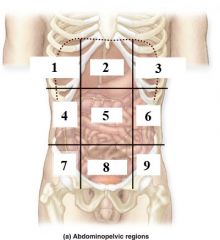
Name the areas of the abdominopelvic region.
|
1. right hypochondriac region
2. epigastric region 3. left hypochondriac region 4. right lumbar region 5. umbilical region 6. left lumbar region 7. right inguinal (iliac) region 8. hypogastric region 9. left inguinal (iliac) region |
|
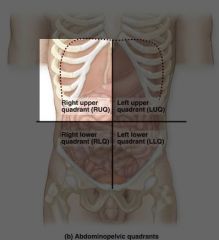
Name the organs found in the RUQ (right upper quadrant) of the abdominopelvic area.
|
liver (right lobe), gallbladder, part of the pancreas, parts of the small and large intestine.
|
|
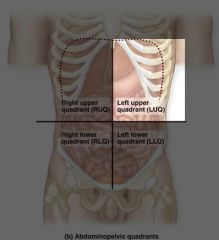
Name the organs found in the LUQ (left upper quadrant) of the abdominopelvic area.
|
liver (left lobe), stomach, spleen, part of the pancreas, parts of the small and large intestines.
|
|
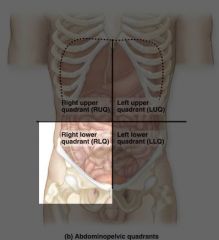
Name the organs found in the RLQ (right lower quadrant) of the abdominopelvic area.
|
parts of the small and large intestines, right ovary, right fallopian tube, appendix, right ureter.
|
|
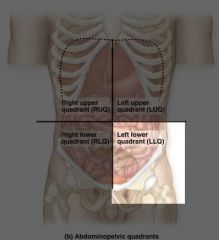
Name the organs found in the LLQ (left lower quadrant) of the abdominopelvic area.
|
parts of the small and large intestines, left ovary, left fallopian tube, left ureter.
|
|
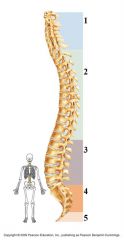
Name the five divisions of the spinal column and the vertebrae they contain.
|
1. cervical (C1--C7)
2. thoracic (T1--T12) 3. lumbar (L1--L5) 4. sacral (S1--S5 - fused to form the sacrum) 5. coccygeal (four fused bones form the coccyx) |
|
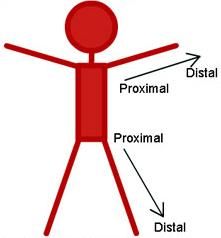
Explain the meaning of proximal and distal.
|
Proximal means nearest to the point of attachment to the trunk or near the beginning of a structure. Distal is far from the point of attachment or beginning of a structure.
|
|

Name the plane of the body pictured here.
|
Frontal Plane
or Coronal Plane |
|

Name the plane of the body pictured here.
|
sagittal plane
or lateral plane |
|
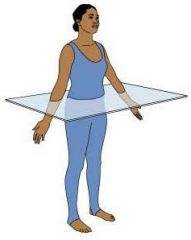
Name the plane of the body pictured here.
|
transverse plane
or cross-sectional plane or axial plane |
|
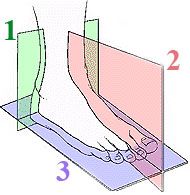
Name the 3 planes of the body as shown here.
|
1. Frontal (coronal) plane
2. Sagittal (lateral) plane 3. Transverse (cross-sectional, axial) plane |
|
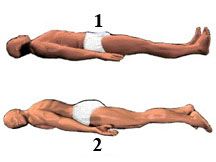
Name the body positions shown here.
|
1. supine
2. prone |
|
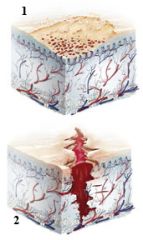
Image number one shows a ________ wound because it is on the surface.
Image number two shows a ______ wound, meaning it is away from the surface. |
1. superficial
2. deep |
|
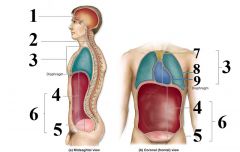
Name the body cavities shown in the diagram.
|
1. Cranial
2. Spinal (Vertebral) 3. Thoracic 4. Abdominal 5. Pelvic 6. Abdominopelvic 7. Mediastinum 8. Pleural 9. Pericardial |
|
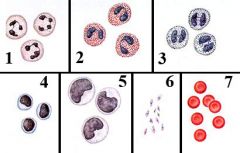
Name the following blood cells and explain their function.
|
1. neutrophils: disease-fighting cells that engulf and digest bacteria
2. eosinophils: are active and increase in number in allergic conditions 3. basophils: number increases in the healing phase of inflammation 4. lymphocytes: fight disease by producing antibodies. 5. monocytes: large phagocytes that engulf and destroy cellular debris after neutrophils have attacked foreign cells. 6. thrombocytes (platelets): necessary for blood clotting. 7. erythrocytes: contains hemoglobin which carries oxygen through the bloodstream |
|
|
Fill in the blanks on the following chart for singular and plural forms:
Singular Plural A ____ ____ ACES EN ____ IX, EX ____ ____ SES ON ____ UM ____ ____ I Y ____ ____ MATA |
Singular Plural
A AE AX ACES EN INA IX, EX ICES SIS SES ON A UM A US I Y IES MA MATA |

